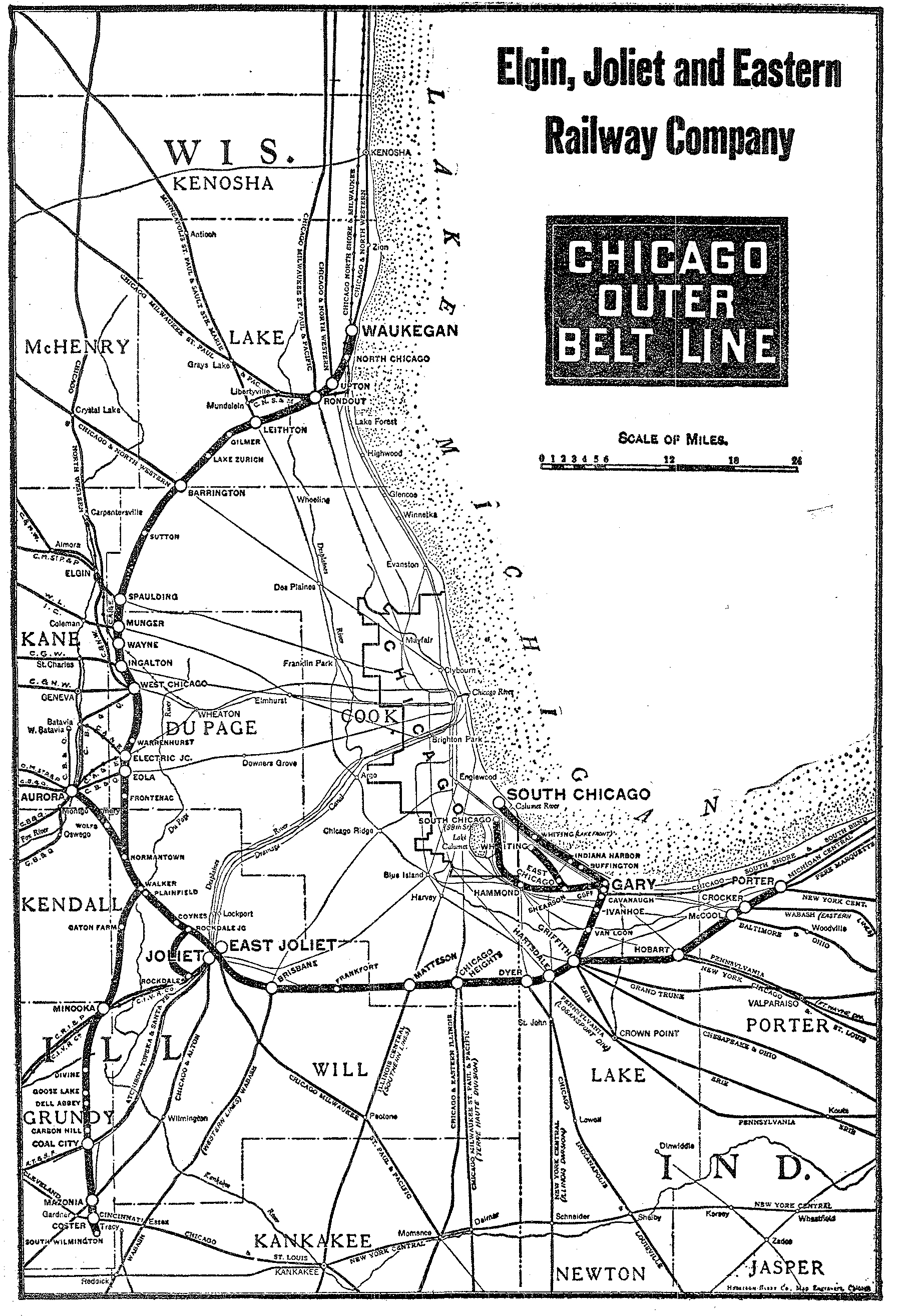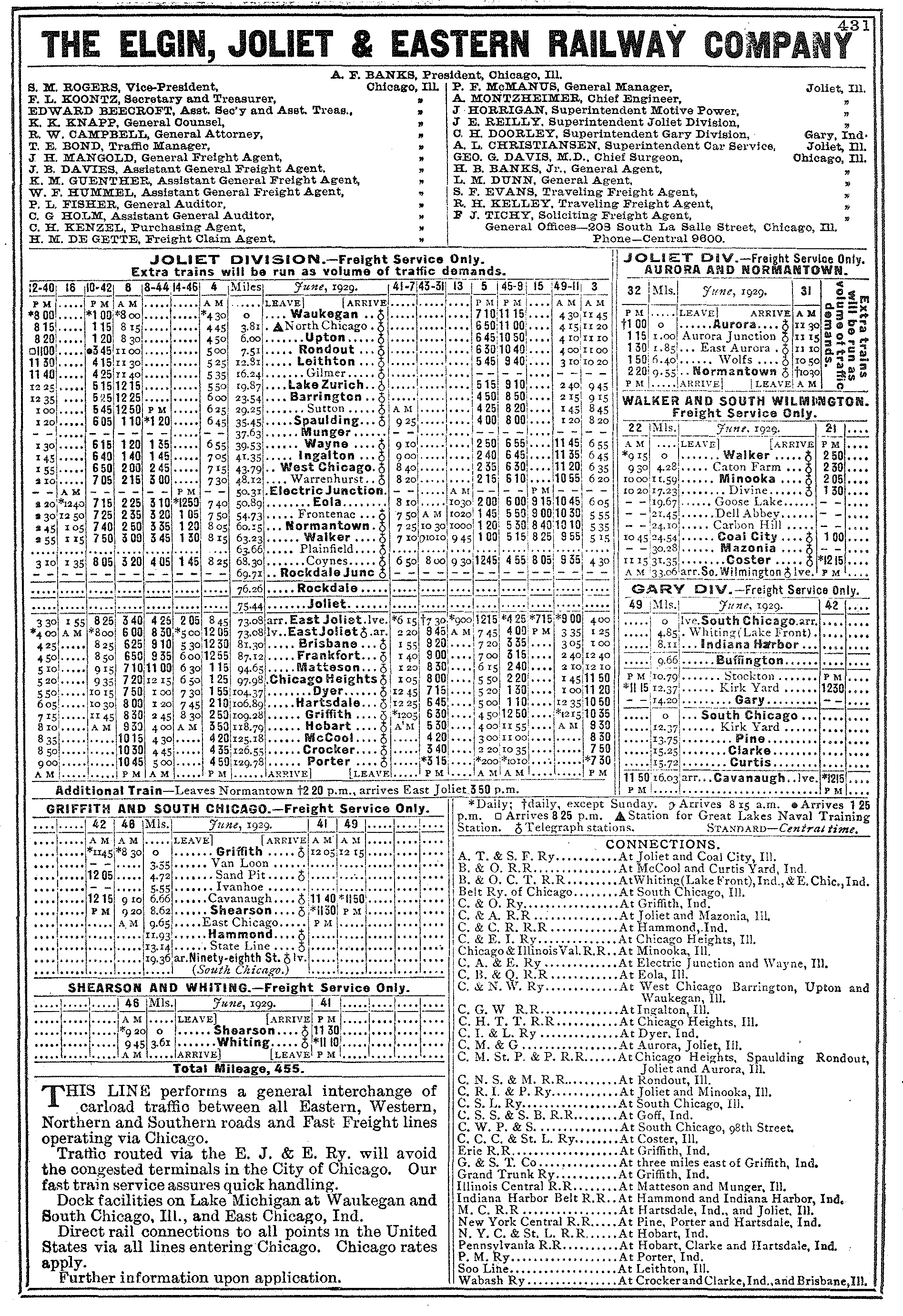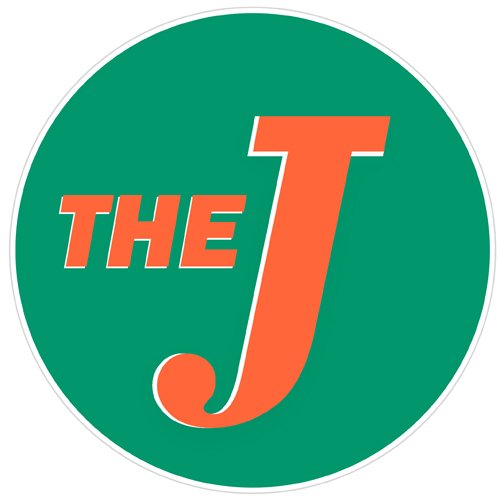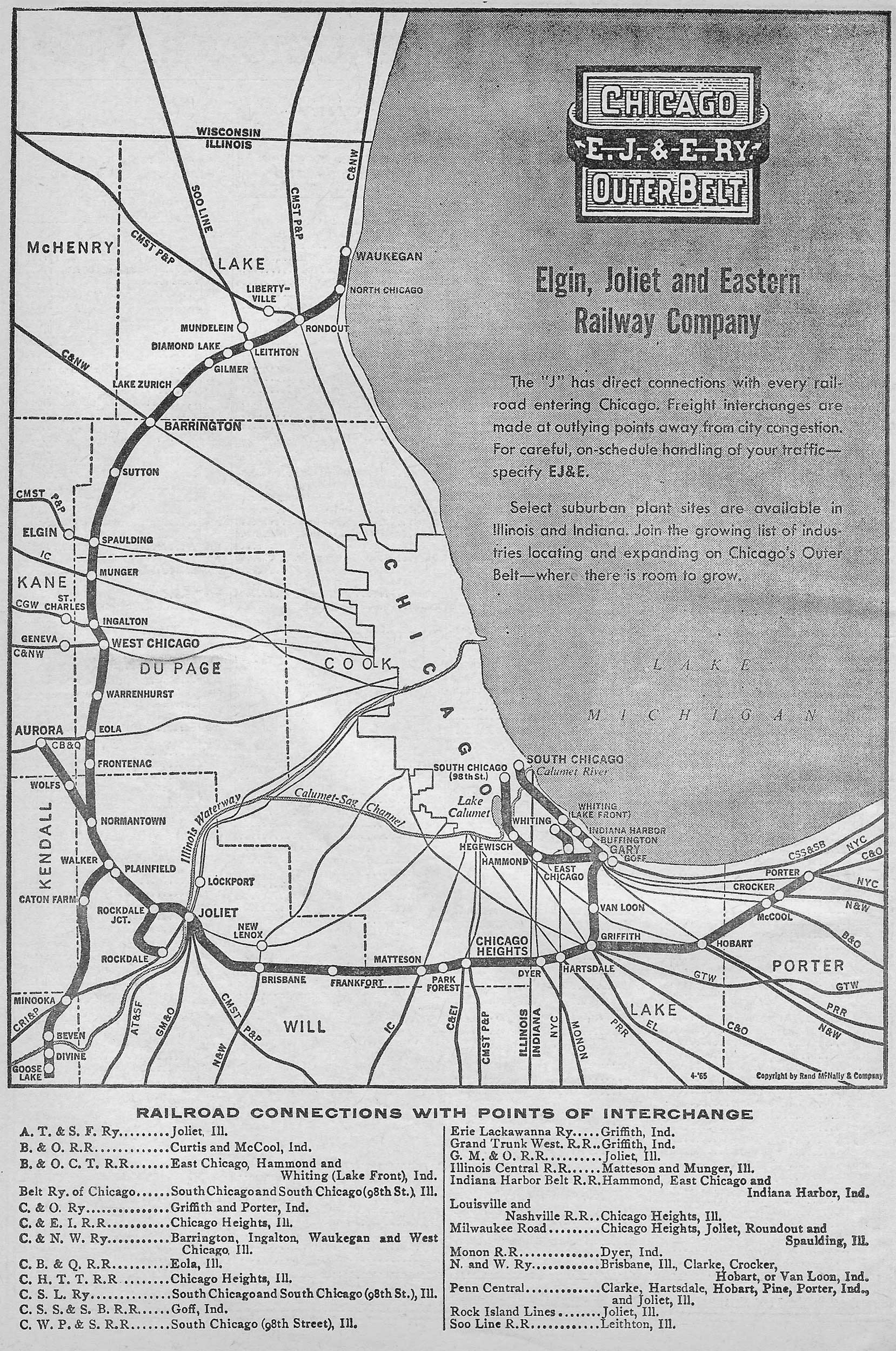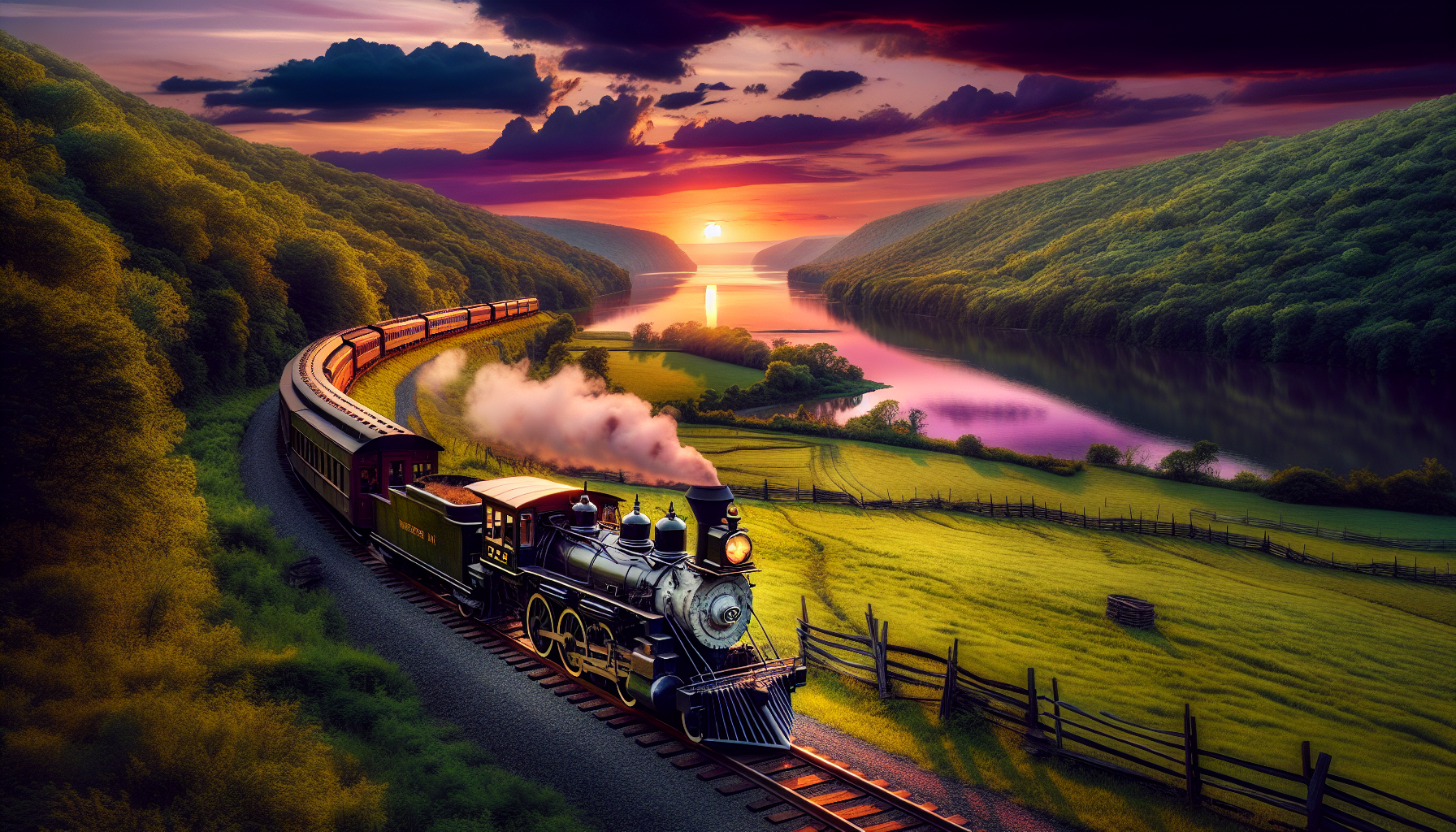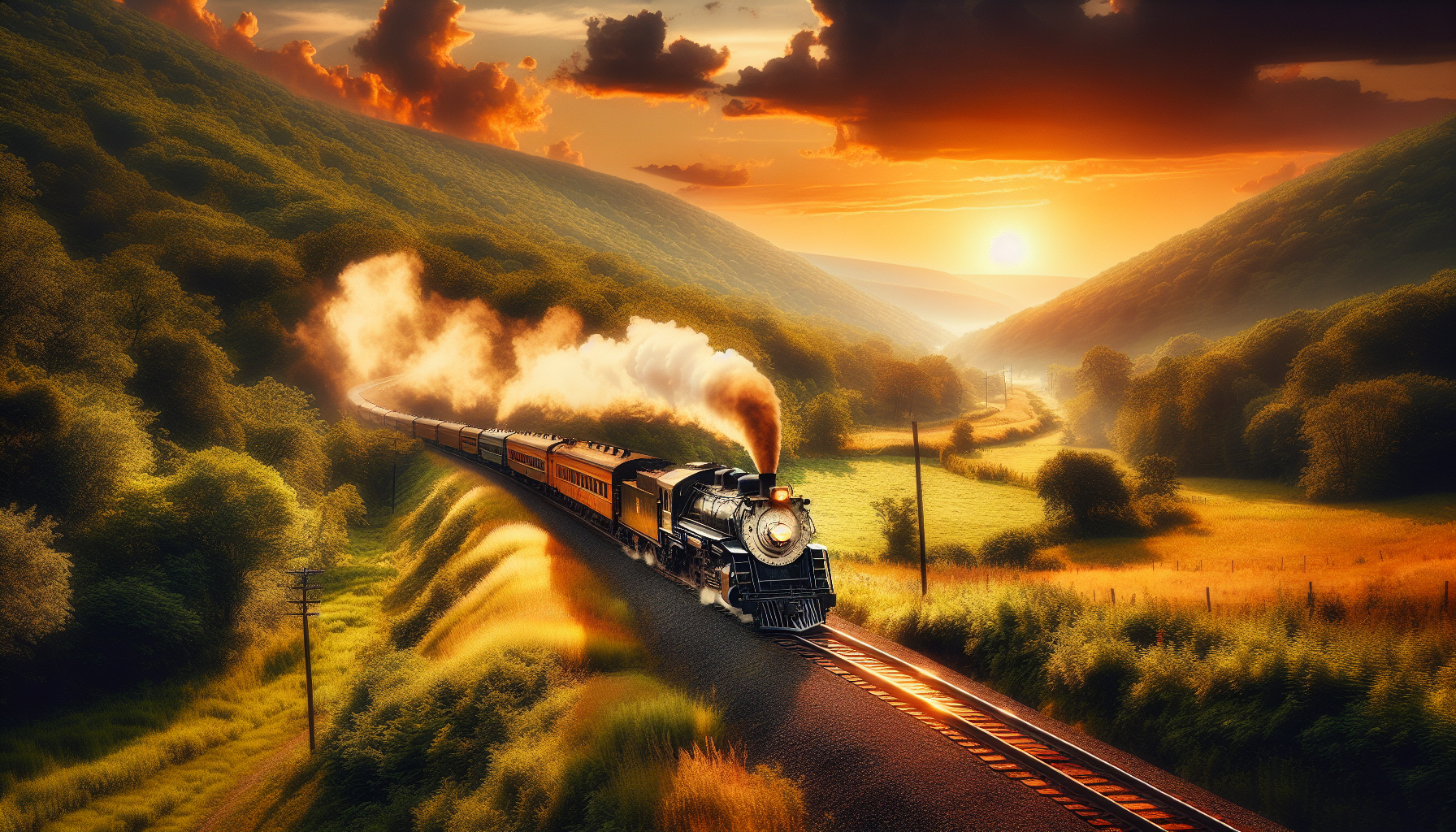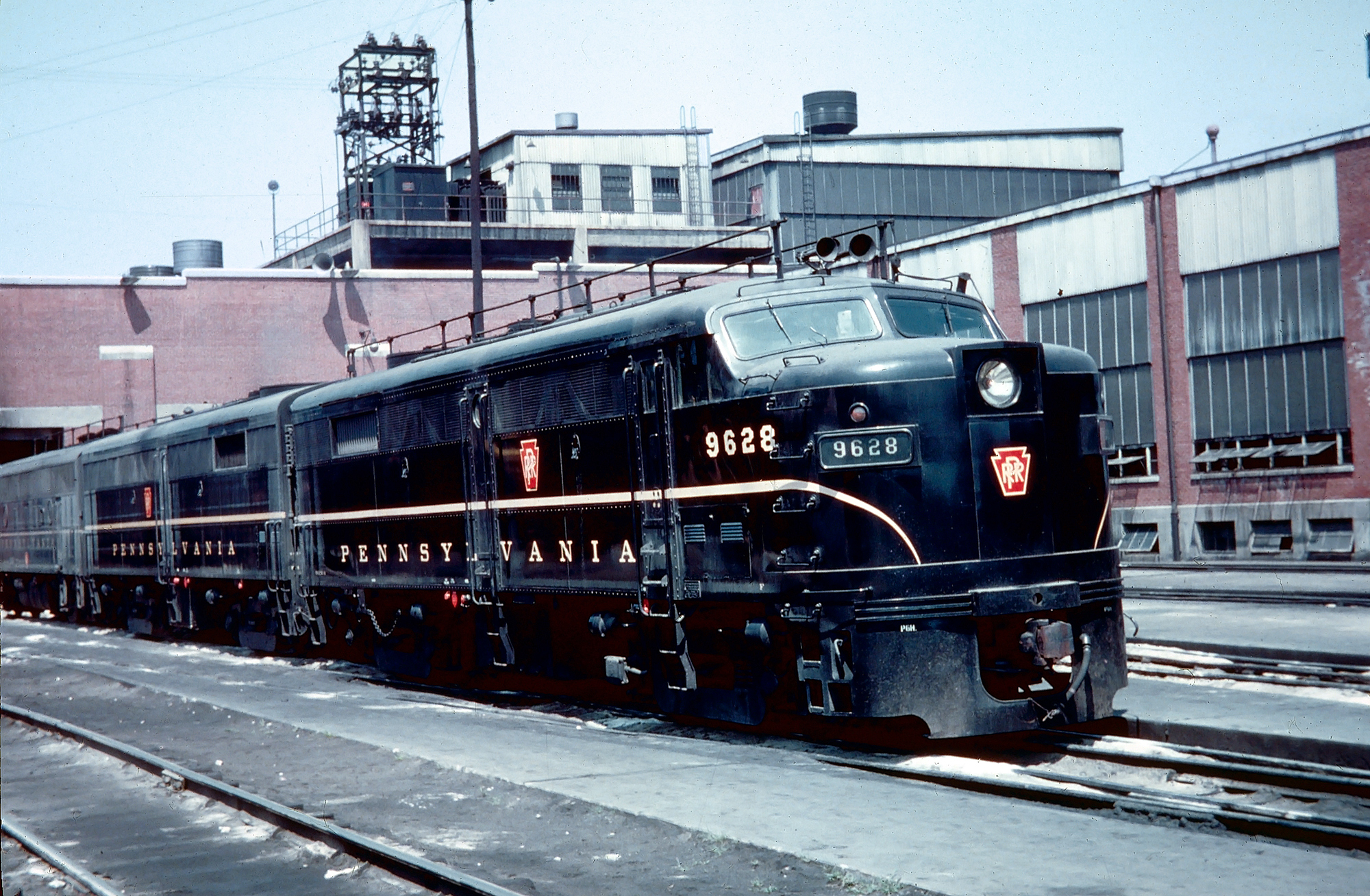Elgin, Joliet and Eastern Railway: Map, Roster, History
Last revised: August 23, 2024
By: Adam Burns
What became the Elgin, Joliet and Eastern Railway is thanks largely to the work of Philip Shumway who wanted to establish an efficient belt line around the entirety of Chicago.
In many ways the EJ&E was not even a belt road and far different from the city's two other notables, the Belt Railway of Chicago and Indiana Harbor Belt.
While a branch did reach South Chicago, EJ&E's main line was situated far away from the Loop (downtown) and handled as much through traffic as it did terminal/interchange business.
From an early era it abandoned passenger trains, shifting focus exclusively to freight. When Shumway ran into financial trouble he found a backer in J.P. Morgan and the banking mogul saw great promise in the idea.
With limitless capital available the railroad was soon completed as it reached northern Indiana and points above Chicago. In time, "The J" connected with all surrounding railroads serving as an important relief valve which bypassed an increasingly congested city.
After more than a century of service it was acquired by Canadian National in 2009 and its corporate name dissolved a few years later.
Photos
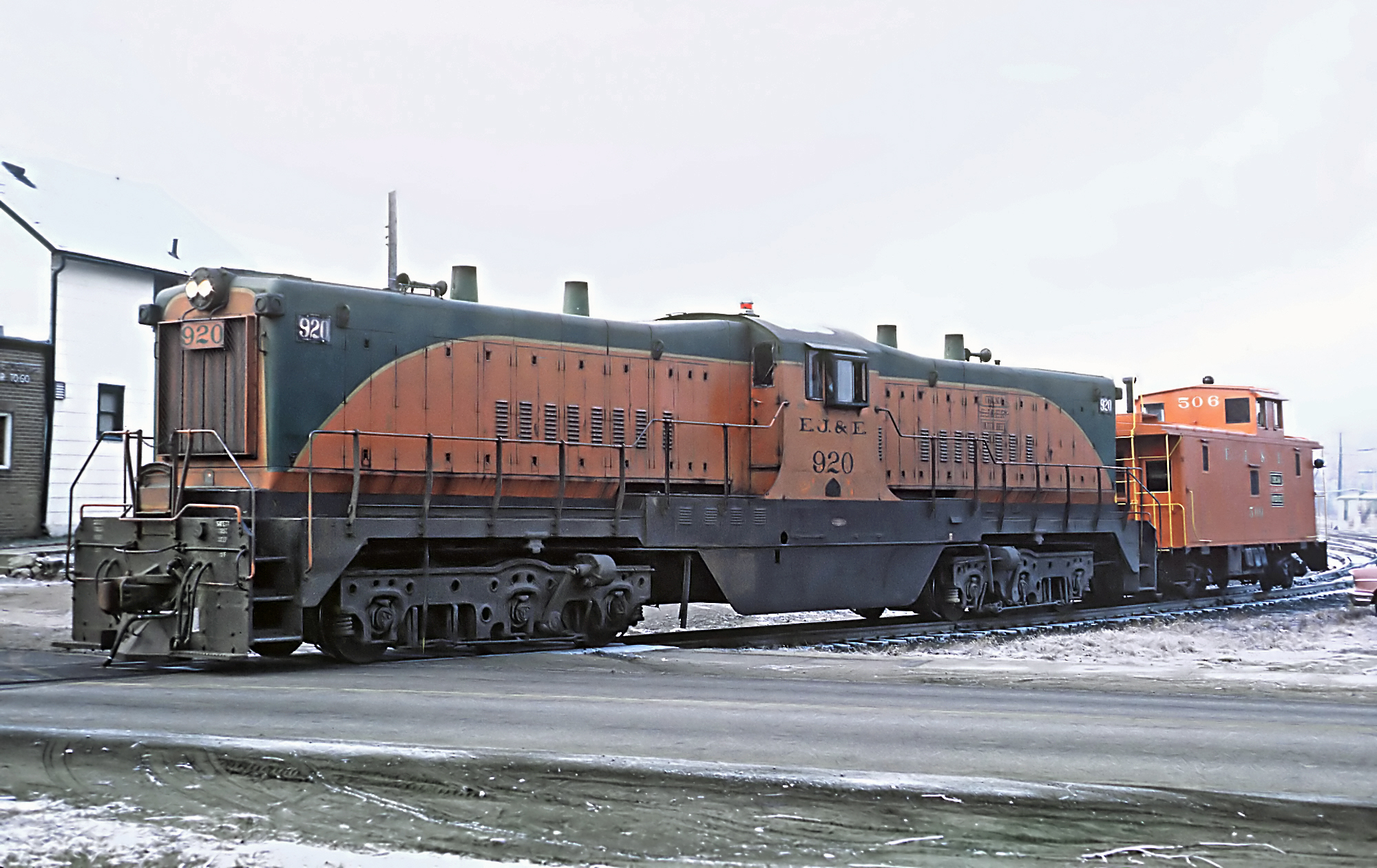 Elgin, Joliet & Eastern DT-6-6-2000 #920 is seen here on a caboose hop at Griffith, Indiana in January, 1965. Roger Puta photo.
Elgin, Joliet & Eastern DT-6-6-2000 #920 is seen here on a caboose hop at Griffith, Indiana in January, 1965. Roger Puta photo.History
The Elgin, Joliet & Eastern Railway was sort of a hybrid; it was not exactly a belt line although its main line did, indeed, encircle Chicago. It contained characteristics of a line-haul system with a 175-mile corridor connecting the eastern trunk lines in northeastern Indiana with their Midwestern counterparts in Illinois.
The "J" was also closely tied to the steel industry, moving coal, coke, and iron ore to mills dotting its right-of-way. Its history began with Philip Shumway, a local businessman who envisioned a belt line serving Chicago and its suburbs.
The railroad would not only tie together the city's preeminent trunk lines but also serve Joliet's growing industrial base. According to Michael Blaszak's excellent article entitled "The J: A Centennial History, Big Steel's Belt Line," from the August, 1989 issue of Trains Magazine, in 1881, Shumway, Alex Leith of Joliet Iron & Steel, and a few other individuals formed the Joliet & Indiana Railroad.
Its purpose was to open the initial eastern leg, running from Joliet to the Indiana/Illinois state line. Unfortunately, the group failed to secure financing and the charter lay dormant.
At A Glance
Porter, Indiana - Griffith, Indiana - Joliet, Illinois - Aurora, Illinois Griffith - Gary - South Chicago, Indiana/Hammond, Indiana Coster - Coal City - Walker, Illinois Rockdale Junction - Rockdale Normantown - West Chicago - Spaulding, Rondout - Waukegan, Illinois | |
The idea was revived a few years later when Shumway became involved with another group attempting to establish a similar, but more ambitious project.
Known as the Joliet, Aurora & Northern Railroad (JA&N), incorporated on March 22, 1884, it was the ambitious plan of Daniel Roberts to extend rails northwestward from Joliet to the east bank of the Mississippi River near Dubuque, Iowa. The JA&N would also head east to the Indiana state line.
This scheme was also in danger of stalling until two events occurred; Shumway's interest and that of the Chicago, Milwaukee & St. Paul (CM&StP). This early predecessor of the Milwaukee Road recognized the JA&N could offer it an efficient connection with eastern carriers while avoiding downtown Chicago.
In February of 1886, Shumway acquired partial control of the JA&N and was able to secure financing to build the first 22 miles between Joliet and Aurora. With relatively gentle topography and few obstacles encountered, work proceeded quickly. The line was ready for service by August 15, 1886 but unfortunately, business never took off as hoped.
Timetables (1930)
Everything seemed lost until Shumway approached J.P. Morgan about funding the struggling enterprise. The banking giant liked what he saw, so much so he decided to buyout everyone's stakes and take direct control himself.
By early 1887 Morgan had full ownership and seemingly overnight, the railroad was on solid financial footing. To build the proposed belt line a new system was chartered, the Elgin, Joliet & Eastern Railway established on March 18, 1887.
One of the first tasks involved building locomotive repair/general maintenance facilities, which were located on the east side of Joliet.
Next, work proceeded with haste to finally open a connection with the CM&StP while simultaneously eyeing the eastward extension into Indiana.
Extending from what became the Aurora Branch at Normantown, the EJ&E opened an interchange with the CM&StP at a point known as Spaulding, slightly east of downtown Elgin in late July of 1888.
It then pushed towards Indiana (via a subsidiary known as the Elgin, Joliet & Eastern Railway of Indiana), opening a connection with the Pennsylvania Railroad at Hobart on September 24th.
A few months later a Baltimore & Ohio interchange was established at McCool. Finally, on June 22, 1893 the Lake Shore & Michigan Southern (New York Central) and Chicago & West Michigan (a predecessor of the Pere Marquette Railway, which later came under Chesapeake & Ohio control) were reached at Porter.
Logo
While all of this was ongoing, a third extension commenced to the southwest of Joliet. This new branch, incorporated as the Gardner, Coal City & Northern Railway (GCC&N) on April 4, 1888, would exclusively serve the Braidwood coalfields near Braceville, owned by the CM&StP.
Construction began that August and opened just a few months later on October 29th, running from Walker (near Plainfield) to Gardner, a distance of 35 miles (it was later extended to South Wilmington in 1899 to serve additional mines).
With numerous interchanges now established on all fronts, Shumway's dream was quickly becoming reality (unfortunately, he never lived to see the completed EJ&E, passing away on May 9, 1887 of a stroke). A corporate restructuring took place on December 4, 1888 when the predecessors were merged into the Elgin, Joliet & Eastern Railway.
While the paperwork was simplified this did not curtail further growth. Less than a year after the Gardner Branch opened yet another important extension was launched to push rails further north beyond Spaulding. It was the idea of F.E. Worcester, who headed the EJ&E after Shumway's death.
System Map (1965)
He proposed a line to the-then small community of Waukegan, which offered ample acreage for industrial development. It also provided a natural harbor for lake boats.
Along the way additional interchanges were established with the Chicago & North Western (Waukegan); Chicago, Milwaukee & St. Paul (Rondout); Wisconsin Central/Soo Line (Leithton); and another C&NW connection at Barrington.
The Morgan interests were excited about the idea and quickly put plans into motion for its construction, establishing the Waukegan & Southwestern Railroad. The project began in July of 1889 and was ready for service by the following January.
The gamble paid off as numerous businesses were attracted to the Waukegan area, in part due to the "J's" many interchanges.
As evermore trunk lines partnered with the EJ&E it earned its first profit in 1894 and then expanded again in 1897 by acquiring the Western Indiana Railroad. This small system's original intentions were to build from Hammond to La Porte. However, it had little success and only managed to open a short 1-mile segment in the Hammond area.
After E&JE's acquisition the line was pushed to Whiting, via East Chicago, a distance of 7 miles. While not a particularly large venture it did serve several industries, including Standard Oil's refinery at Whiting.
The final major extension came just before the "J's" acquisition by United States Steel Corporation, formed on February 25, 1901 (America's first billion-dollar company created by none other than J.P. Morgan).
As Mr. Blaszak's article notes, Illinois Steel, one of the country's largest producers, decided to acquire the EJ&E in 1898 as part of its initiative to establish vertical integration.
This concept meant that a steel producer would own and control every aspect of production, including transportation and even raw materials (iron ore and coal mines). When purchasing the "J," Illinois Steel folded its industrial carrier, the Chicago, Lake Shore & Eastern Railway, into its new subsidiary.
The CLS&E was established in 1895 and eventually came to operate all railroads serving its parents' five mills (South Works situated along the Calumet River southeast of Chicago, North Works at Clybourn Avenue, Union Works in Bridgeport, Milwaukee Works in Milwaukee [Wisconsin], and the Joliet Works).
At the South Works this included trackage running the lake front southeastward to Clarke Junction where interchange was established with the B&O and LS&MS.
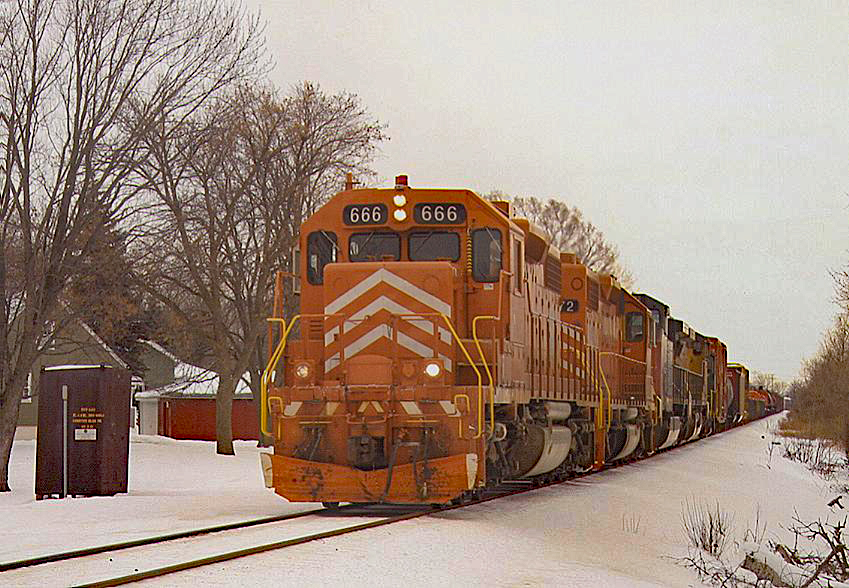 Elgin, Joliet & Eastern SD38-2 #666 leads its train through the southeast side of Joliet, Illinois. Doug Kroll photo.
Elgin, Joliet & Eastern SD38-2 #666 leads its train through the southeast side of Joliet, Illinois. Doug Kroll photo.The only thing remaining was directly linking this trackage with the rest of the EJ&E system, a project completed in 1900 between Griffith and Clarke Junction via a subsidiary known as the Griffith & Northern.
The corporate maneuverings at this time were many and dizzying. Morgan had no more than sold the EJ&E to Illinois Steel when he laid the ground for what became U.S. Steel.
On September 8, 1898 he and an associate, Elbert H. Gary (better remembered as "Judge"), placed the EJ&E, Minnesota Iron Company, Duluth & Iron Range (serving Minnesota's iron-rich Vermilion Range), Minnesota Steamship Company, and Illinois Steel under a new holding company known as Federal Steel.
Only a few years later, steel magnate Andrew Carnegie elected to retire from corporate life and sold his steel interests to Morgan in 1901, which included the Bessemer & Lake Erie Railroad and Pittsburgh Steamship Company. At the time, Carnegie was the largest steel producer in the country.
According to John Leopard's book, "Duluth, Missabe & Iron Range Railway," the next component of U.S. Steel was John D. Rockefeller's interests acquired in March of 1901.
They included a laundry list of similar companies:
- Bessemer Steamship
- Duluth, Missabe & Northern (which served the Mesabi Range, it went on to merge with the D&IR to form the Duluth, Missabe & Iron Range in 1938)
- National Steel
- American Bridge Company
- American Steel Hoop Company
- American Steel & Wire
- American Tin Plate
- National Tube
With U.S. Steel's creation it immediately controlled 65% of the market.
Innovations
The Elgin, Joliet & Eastern was a very early proponent of the diesel locomotive, acquiring its first diesels from Electro-Motive in 1936. It had little use for cab models although did experiment with Baldwin's DR-4-4-1500 demonstrator for a year before selling these to the Baltimore & Ohio in 1950.
Perhaps its most interesting and exotic model was the DT-6-6-2000 transfer switcher, another product of Baldwin. This locomotive entered the builder's catalog precisely because of the "J," which requested a large design that could handle heavy tonnage at slow speeds between closely spaced terminals; the hallmark of the transfer type.
The EJ&E went on to acquire 26 examples, some of which remained in service into the 1970's (after being re-engined with EMD prime movers). The "J" was also an early adopter of welded rail, installing its first 131-pound segments in the fall of 1943.
While much more expensive than utilizing traditional joints, "ribbon" rail reduces maintenance and offers a smoother ride; by 1950 the EJ&E had installed 90 miles of its 175-mile network with CWR (continuous welded rail) and continued to do so after that time.
Modern Era
By the turn of the century the modern "J" was in place and would change little over the next several decades. Its traffic ebbed and flowed, peaking at 45.9 million tons in 1944 during World War II.
Dedicated passenger service was extremely short-lived, lasting only until 1907 when mixed trains were implemented as the company focused exclusively on its interchange and line-haul freight business. Mixed service survived until the mid-1960's when all passenger operations ended.
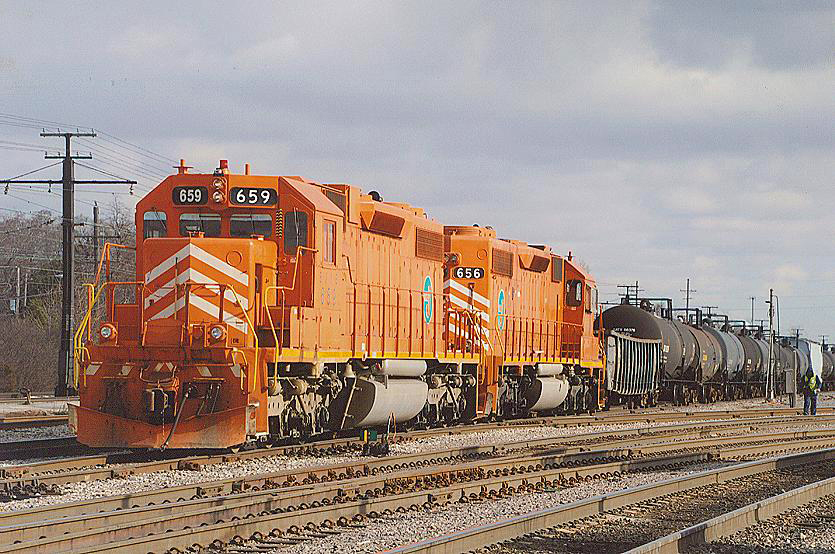 A pair of Elgin SD38-2's pull a cut of cars through the former Illinois Central's Markham Yard (Canadian National) in Homewood, Illinois on March 26, 2011. Doug Kroll photo.
A pair of Elgin SD38-2's pull a cut of cars through the former Illinois Central's Markham Yard (Canadian National) in Homewood, Illinois on March 26, 2011. Doug Kroll photo.During the depression era the EJ&E experienced its first cutbacks, removing 12 miles of the old GCC&N in 1935 between Goose Lake and South Wilmington.
The next significant abandonment occurred in the postwar years as the "J" saw its interchange business rapidly declining through mergers and the Class Is' increased use of large classification yards.
These facilities were situated on the outskirts of Chicago and significantly curtailed the need of belt lines. In 1976 much of the Aurora Branch was let go, except for a short stub serving a grain elevator that was eventually removed by 1985.
That same year also saw the 20.4 miles between Griffith and Porter taken up. To continue interchanging with what was then Conrail and Chesapeake & Ohio/Chessie System (soon CSX Transportation), the connection was moved to nearby Gary and Griffith.
Diesel Roster
| Builder | Model Type | Road Number | Date Built/Notes |
|---|---|---|---|
| Baldwin | DT-6-6-2000 | 100 | 5/46, Not Re-engined* |
| Baldwin | DT-6-6-2000 | 101-102 | 2/48, Rebuilt With Baldwin Prime Movers (1957-61) and renumbered 701-702 |
| Baldwin | DT-6-6-2000 | 103 | 2/48, Rebuilt With EMD 12-567C (1956) and renumbered 903 |
| Baldwin | DT-6-6-2000 | 104-105 | 3/48, Rebuilt With Baldwin Prime Movers (1957-61) and renumbered 704-705 |
| Baldwin | DT-6-6-2000 | 106 | 3/48, Rebuilt With EMD 12-567C (1956) and renumbered 906 |
| Baldwin | DT-6-6-2000 | 107 | 3/48, Rebuilt With Baldwin Prime Mover (1958) and renumbered 707 |
| Baldwin | DT-6-6-2000 | 108, 111 | 4/48, Rebuilt With Baldwin Prime Movers (1957-61) and renumbered 708, 711 |
| Baldwin | DT-6-6-2000 | 109-110 | 4/48, Rebuilt With EMD 12-567C's (1956) and renumbered 909-910 |
| Baldwin | DT-6-6-2000 | 112-115 | 4/48-5/48, Rebuilt With EMD 12-567C's (1956) and renumbered 912-915 |
| Baldwin | DT-6-6-2000 | 116, 119 | 6/48, Rebuilt With EMD 12-567C's (1956) and renumbered 916, 919 |
| Baldwin | DT-6-6-2000 | 112-115 | 4/48-5/48, Rebuilt With EMD 12-567C's (1956) and renumbered 912-915 |
| Baldwin | DT-6-6-2000 | 117 | 6/48, Rebuilt With Baldwin Prime Movers (1958) and renumbered 717 |
| Baldwin | DT-6-6-2000 | 118 | 6/48, Not Re-engined |
| Baldwin | DT-6-6-2000 | 120-121 | 7/48, Rebuilt With EMD 12-567C's (1956) and renumbered 920-921 |
| Baldwin | DT-6-6-2000 | 122-123 | 8/48, Rebuilt With Baldwin Prime Movers (1958) and renumbered 722-723 |
| Baldwin | DT-6-6-2000 | 124-125 | 8/48, Rebuilt With EMD 12-567C's (1956) and renumbered 924-925 |
| Baldwin | DT-6-6-2000 | 126 | 6/50, BLW Demo #2002; Rebuilt With Baldwin Prime Movers (1958) and renumbered 726 |
| EMC | SW | 200-208 | 12/36-9/37** |
| Alco | HH-660 | 209-212 | 9/37-3/40 |
| Alco | S1 | 213-217 | 1/40-12/40 |
| EMC/EMD | SW1 | 220-246 | 1/40-11/41 |
| EMC/EMD | SW1 | 249 | 7/49, Ex-Canton #25 |
| Baldwin | VO-660 | 270-272 | 5/40-3/41*** |
| EMD | SW1200 | 300-307 | 5/60-6/60 |
| EMD | TR5Am/Bm | 308-309 | 9/51, Ex-UP |
| EMD | SW1200 | 310-323 | 3/64-4/66, Ex-MP And Ex-KCT |
| EMC | NW1 | 400-401 | 11/37 |
| Alco | HH-900 | 402 | 11/37 |
| EMC | NC | 402 (2nd), 408**** | 5/37 |
| EMC/EMD | NW2 | 403-443 | 9/40-5/49 |
| EMD | SW1001 | 444-445 | 7/71 |
| EMD | SW1001 | 446 (2nd) | 10/68 |
| EMD | NW2 | 446-449 | 1/47-5/47, Ex-CI&L/Monon And Ex-UP |
| EMC | NW2 | 450-452 (2nd) | 8/39-9/39, Ex-Santa Fe |
| EMD | SW900 | 453 (2nd) | 10/56, Ex-GTW |
| EMD | SW9 | 454 (2nd) | 4/52, Ex-C&O |
| EMD | NW2 | 455 (2nd) | 9/49, Ex-C&O |
| EMD | SW8 | 456-457 (2nd) | Ex-PC&Y And Ex-NKP |
| EMD | NW2 | 458 (2nd) | 5/49, Ex-IC |
| EMD | SW1000 | 459 (2nd) | 7/71, Ex-New Orleans Public Belt |
| Alco | S2 | 451-462 | 10/40-8/48 |
| Baldwin | VO-1000 | 475-484 | 1/41-11/44 |
| Baldwin | DRS-6-6-1500 | 500-501 | 1/49, Ex-B&LE |
| EMD | SD9 | 600-602 | 3/57 |
| EMD | SD9 | 603-613 | 3/56-4/59, Ex-DM&IR |
| EMD | SD18 | 615-616 | 4/60, Ex-DM&IR |
| EMD | SD38 | 650-655 | 1/70 |
| EMD | SD38-2 | 656-667, 669 | 1/74-12/75 |
| EMD | SD38-2 | 668 | 11/75, Delivered In Bicentennial Livery |
| Baldwin | DR-4-4-1500 | 700A-701A | 6/49***** |
| Baldwin | DR-4-4-1500B | 700B-701B | 6/49***** |
| EMD | GP38-2 | 700-704 | 12/72-10/73 |
| EMD | SD40M-3 | 750-751 | Ex-C&O |
| EMD | SD40M-2 | 752 | Ex-WM |
| Alco | RS2 | 800-809 | 6/48-11/49 |
| EMD | SDM | 802, 804, 809, 811, 813-815, 818, 820 | Ex-DM&IR |
* Prototype nicknamed, "Golden Goose." Scrapped in 11/61.
** #202-203 converted to slugs #T-3 (July, 1954) and #T-4 (January, 1957).
**** #270 originally Baldwin demonstrator #336; rebuilt to slug #T-5 in 1964.
*** #408 (First) was built as Youngstown & Northern #201 in May of 1937.
***** Baldwin demonstrators, sold to the B&O in January of 1950.
Steam Roster
Roster as of the 1940s.
| Road Number(s) | Class | Wheel Arrangement | Builder | Date Built |
|---|---|---|---|---|
| 27 | - | 0-6-0 | Pittsburgh | 1900 |
| 31 | - | 0-6-0 | Alco | 1901 |
| 34, 37, 44 | - | 0-6-0 | Baldwin | 1903 |
| 46, 50 | - | 0-6-0 | Alco | 1904 |
| 53-54, 56-57, 59-60 | - | 0-6-0 | Alco | 1905 |
| 62-63, 65-66, 69-81, 83-89 | - | 0-6-0 | Alco | 1906-1907 |
| 92-120 | - | 0-6-0 | Alco | 1910 |
| 121 | - | 0-6-0 | H.K. Porter | 1927 |
| 122 | - | 0-6-0 | Baldwin | 1917 |
| 123 | - | 2-6-0 | Baldwin | 1915 |
| 300-301 | AS-1 | 0-8-0 | Baldwin | 1905 |
| 302-311 | AS | 0-8-0 | Alco | 1907-1910 |
| 312-320 | AS-2 | 0-8-0 | Alco | 1916 |
| 321-328 | AS-3 | 0-8-0 | Alco | 1917 |
| 329-336 | AS-4 (USRA) | 0-8-0 | Baldwin | 1919 |
| 528-530 | - | 2-8-0 | Alco | 1907 |
| 539-540 | - | 2-8-0 | Schenectady | 1900 |
| 541-544 | A | 2-8-0 | Baldwin | 1903 |
| 545-548 | A-1 | 2-8-0 | Alco | 1904 |
| 549-599 | A-2 | 2-8-0 | Alco | 1905-1910 |
| 600-602 | A-2* | 0-8-0 | Alco | 1910 |
| 700-755 | AS | 2-8-2 | Alco | 1913-1923 |
| 756-760 | AS | 2-8-2 | Lima | 1923 |
| 761-774 | AS | 2-8-2 | Baldwin | 1929-1930 |
* Rebuilt from 2-8-0's.
The above roster information is thanks, in part, to:
- Patrick Dorin's book, "The Elgin, Joliet & Eastern Railway"
- John Kirkland's book, "The Diesel Builders, Volume III: Baldwin Locomotive Works"
- Michael Blaszak's article, "The J: A Centennial History, Crossing Bridges As They Come," from the September, 1989 issue of Trains Magazine
Final Years
With belt line services in decline and the loss of industrial traffic (particularly steel), the Elgin, Joliet & Eastern switched its focus to originating/terminating traffic after the 1970's.
As the merger movement continued through the 1990's the railroad found its connections reduced to six of the seven remaining Class I carriers; Canadian Pacific, Canadian National, CSX Transportation, Norfolk Southern, Norfolk Southern, and Union Pacific.
Throughout this time the carrier had remained a subsidiary of U.S. Steel, although the domestic market's declines since the 1970's brought several corporate changes. In 1986 U.S. Steel became the USX Corporation (after branching out into the energy and acquiring Marathon Oil and Texas Oil & Gas to prop up sagging profits).
In 1988 it spun-off its transportation holdings into a new subsidiary known as Transtar, which managed its rail assets (most notably these included Bessemer & Lake Erie; Birmingham Southern; Lake Terminal; McKeesport Connecting; Union Railroad; Elgin, Joliet & Eastern; and Duluth, Missabe & Iron Range).
Canadian National Acquisition
That June, 51% of the new company was sold to Blackstone Capital Partners, which officially acquired the properties on December 28th. In an interesting twist, USX reacquired 100% of Transtar in 2001, albeit minus the DM&IR and B&LE which were under different ownership as part of Great Lakes Transportation.
This remained unchanged for nearly a decade until January 31, 2009 when Canadian National acquired the EJ&E from Transtar, eyeing its potential as a Chicago bypass. Then, on January 1, 2013 the legendary "J" formally disappeared as a corporate entity when it was merged into CN-subsidiary Wisconsin Central Ltd.
Contents
Recent Articles
-
Mother's Day Train Rides In New York (2025): A Complete Guide
Mar 17, 25 03:08 PM
Spend the day with Mom at one of several heritage railroads in New York hosting Mother's Day themed train rides. -
Mother's Day Train Rides In Pennsylvania (2025): A Complete Guide
Mar 17, 25 02:43 PM
Mother's Day -
Pennsylvania Railroad (PRR) Diesel Roster: All-Time List
Mar 16, 25 01:14 PM
This information provides an all-time list of the Pennsylvania Railroad's many diesel locomotives, including types and road numbers.
